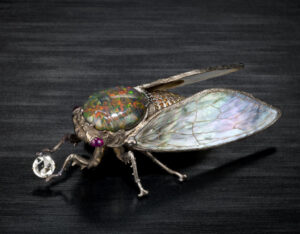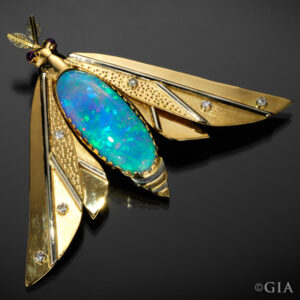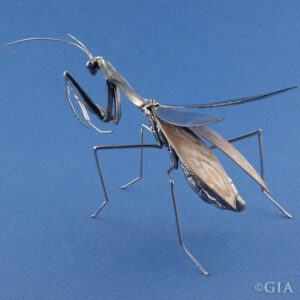We typically think of insects as pesky critters that make us squirm. Caterpillars, flies, and moths are not what many would consider the winners of Mother Nature’s beauty pageant.
But in the hands of imaginative jewelry designers, these creepy crawlers become majestic winged creatures dressed up in diamonds, rubies, pearls, and other spectacular gemstones. And just as a caterpillar turns into a butterfly, master jewelers take raw elements and transform them into wearable works of art.
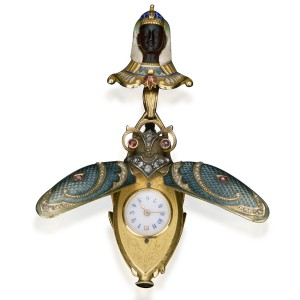
Victorian (circa 1865) Egyptian revival scarab watch. Courtesy of Mona Nesseth and Michelle Laurenti
This Victorian (circa 1865) Egyptian revival scarab watch is crowned with a pharaoh’s head of carved carnelian and a headdress of green and blue enameled gold. It supports a pendant of an enameled scarab with ruby eyes and rubies and diamonds set in the wings. Press a button at the base and the wings open to reveal a small watch set in engraved gold. The underside of the scarab is also realistically engraved – the finishing touches of an exceptionally complex piece.

caterpillar made of pearls with ruby prolegs and diamond eyes. Gift of Avi Raz of and Pearls, Inc. (c) GIA & Tino Hammid
Creating a caterpillar out of pearls is a leap of creative genius. The body is one large freshwater pearl formed when four pearls grew together in an oyster. The caterpillar’s head is a medium-dark gray keshi pearl set with two full cut round brilliant diamonds for the eyes and nine bezel-set cabochon rubies for the prolegs. The leaf below the caterpillar is another freshwater cultured pearl; the gold leaf on the right has 27 round cut dark-green sapphires. This caterpillar is so beautiful that it doesn’t even need to turn into a butterfly.
Wallace Chan’s one-of-a-kind ‘Zen’ cicada brooch is startlingly lifelike. Notice the hairs on the legs ; the veins on the hand-carved mother of pearl wings; the beautiful black opal head. Other painstaking touches by Chan include the ruby eyes and the diamond the cicada holds with its legs . The cicada has long been celebrated as the symbol of Zen in Chinese poetry. This cicada design, iconic to Wallace Chan, was inspired by a calligraphy artist from the Tang dynasty, who wrote a poem about the winged creature.
An Art Deco moth? Sounds strange, but it perfectly describes this design from Wallace Goldsmithing’s Opal Natural Wonders Collection. Layered yellow and white gold gives the “Moth Enhancer” an architectural feel. The angular lines of the wings make it look as if it were getting ready to take flight. The dazzling 25-carat Brazilian crystal opal body makes it look a bit surreal.

Tony Duquette’s ‘Fantastic Cicada’. Courtesy of the Anthony & Elizabeth Duquette Foundation for the Living Arts.
Hollywood set designer Tony Duquette brought an unmistakable theatrical flair to his “Fantastic Cicada.” The malachite body is dramatic. The unique use of enamel paint on the legs and dangling appendages showcase Duquette’s sensibility as a costume designer. Its sharp points and rough edges make it feel like this insect belongs in Little Shop of Horrors.
This praying mantis is an especially unusual piece. The sculpture is a solid silver cast of a real praying mantis (a dead one was used to make the mold), making it an exact replica. The bottom wings showcase the ancient and difficult Japanese mokume gane technique , which involves welding thin layers of different metals together without solder and flux . The resulting wood grain appearance is the tell-tale sign of mokume gane. The upper wings were the artist’s inspiration. The finished piece looks like it could be out hunting for metallic prey.
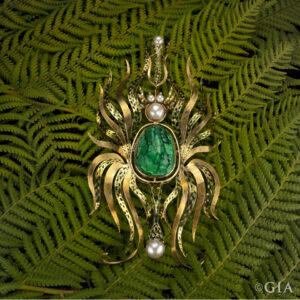
Tony Duquette’s ‘Phoenix Spider’. Courtesy of the Anthony & Elizabeth Duquette Foundation for the Living Arts.
Although not technically an insect, we couldn’t resist adding this spectacular spider to the mix. .” This 1970s brooch features an ingenious use of enamel, accentuating the malachite body and pearled head and hanging pearl sack. This is no everyday arachnid: she is the queen of her realm, a goddess ready to feast or give birth to a new brood.
The fashion heroes of the insect world used to be the showy butterflies, ladybugs or dragonflies. What do you think about this latest cast of creatures? Would they have a place in your jewelry wardrobe?
Custom Field: Array

